Das erste Metalalbum war ...
Moderator: Loomis
Re: Das erste Metalalbum war ...
zeig mir mal was von Quo das wirklich HEAQVY einschlĂ€ge /Proto-tendenzen erkennen lĂ€sst. Bei Molly Hatchet findste teilweise sowas, aber bei Quo is mir absolut nix bekannt. Wir reden hier ja von so Kapellen qie Uriah Heep oder Deep Purple. Die konnten auch ne bedrohliche athmosphĂ€re schaffen, Quo kenne ich nur als fröhlichen "Stadionrock". Ich lass mich gern eines anderen belehren, aber fĂŒr mich sind sie die Blaupause eines langweiligen Bikerfest-Headliners.
"Datt is wie'n Computer mein Kopp, ne?"
Peter Ludolf, deutscher Philosoph, Denker und Mechaniker, 2008
Peter Ludolf, deutscher Philosoph, Denker und Mechaniker, 2008
-
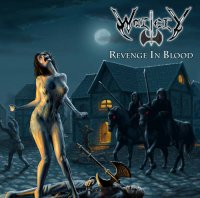
GravewarrioR - Villain-EP-Original-Besitzer
- BeitrÀge: 955
- Registriert: 19. April 2010, 15:38
- Wohnort: Germersheim
Re: Das erste Metalalbum war ...
Seltsam, dass hier noch keiner COVEN erwÀhnt hat.
Gerade mit ihrem Image fielen die anno 69' ziemlich aus dem Rahmen
Geiles Album ĂŒbrigens.
Gerade mit ihrem Image fielen die anno 69' ziemlich aus dem Rahmen
Geiles Album ĂŒbrigens.
Face of a clown
Mind of a madman
Dress of a Jester
Intentions of a killer
Mind of a madman
Dress of a Jester
Intentions of a killer
-

Max Savage - Metalizer
- BeitrÀge: 6655
- Registriert: 3. August 2009, 14:47
- Wohnort: Malnéant
Re: Das erste Metalalbum war ...
GravewarrioR hat geschrieben:zeig mir mal was von Quo das wirklich HEAQVY einschlĂ€ge /Proto-tendenzen erkennen lĂ€sst. Bei Molly Hatchet findste teilweise sowas, aber bei Quo is mir absolut nix bekannt. Wir reden hier ja von so Kapellen qie Uriah Heep oder Deep Purple. Die konnten auch ne bedrohliche athmosphĂ€re schaffen, Quo kenne ich nur als fröhlichen "Stadionrock". Ich lass mich gern eines anderen belehren, aber fĂŒr mich sind sie die Blaupause eines langweiligen Bikerfest-Headliners.
Also als "langweiligen Biker-Rock" wĂŒrde ich alles bis etwa 1978 ja nicht gerade bewerten. In meinen Ohren durchaus auf einer HĂ€rtestufe mit so mancher NWOBHM-Band, gerade wenn ich an Bands wie Quartz oder Tygers denke, ist das nicht weit weg:
- The sound was so big I swear it created a new fjord behind us. -
-

Dr. Best - JOHN ARCH
- BeitrÀge: 4514
- Registriert: 28. April 2009, 11:41
- Wohnort: Brig
Re: Das erste Metalalbum war ...
Max Savage hat geschrieben:Seltsam, dass hier noch keiner COVEN erwÀhnt hat.
Gerade mit ihrem Image fielen die anno 69' ziemlich aus dem Rahmen
Geiles Album ĂŒbrigens.
COVEN hatten zwar das okkulte Image, aber musikalisch sind sie Welten vom Heavy Metal entfernt.
Ich bin mal einen Bestand von alten Musikmagazinen zwischen 1969 und 1975 durchgegangen. Das erste Review, in dem ich die Bezeichnung "Heavy Metal" in Bezug auf eine Band entdeckt habe, stammt aus dem Jahr 1970. Es geht um HUMBLE PIE's zweites Album. Das Review findet sich im Rolling Stone vom 12. November 1970 und wurde verfasst von Mike Saunders.
Black Sabbath wurden zur gleichen Zeit in der Regel noch als "Heavy Music" oder "Heavy Rock" bezeichnet.
Zu den Bands, die vor 1975 in den Magazinen als "Heavy Metal" bezeichnet wurden, zÀhlten unter anderem:
HUMBLE PIE, BLACK SABBATH, LED ZEPPELIN, GRAND FUNK RAILROAD, BLUE ĂYSTER CULT und DEEP PURPLE.
Im Phonograph Record Magazine vom April 1973 hab ich einen superinteressanten Artikel namens "A Brief Survey Of The State Of Metal Music Today" gefunden, ebenfalls von Mike Saunders verfasst. Das zeigt, dass "Heavy Metal" als Genrebezeichnung spÀtestens 1973 in den USA etabliert war, sonst hÀtte so ein Artikel keinen Sinn gemacht.
Die Bands, die in dem Artikel als "Heavy Metal" bezeichnet werden, sind: LED ZEPPELIN, BLACK SABBATH, URIAH HEEP, BLUE ĂYSTER CULT, GRAND FUNK RAILROAD, HAWKWIND (!!!), ALICE COOPER, DUST, MC5, THE STOOGES, TEN YEARS AFTER, UFO, VELVET UNDERGROUND (!!!) und als VorlĂ€ufer THE WHO und THE YARDBIRDS.
Saunders schreibt im gleichen Artikel auch noch drĂŒber, was fĂŒr ihn das Neue und Innovative an Heavy Metal darstellt:
It's easy to note the changes in rock structure that heavy metal groups have employed: increased song length, for one. Five minutes has been about the average metal song duration, often even without any extended solos. Some stompers, like Dust's âFrom A Dry Camelâ and Led Zep's âWhen The Levee Breaksâ, run upwards of seven minutes, and none the worse for it.
Another metal innovation, perhaps the most obvious, would be the overwhelming emphasis on instrumental work rather than vocals. Save Uriah Heep, there have hardly been any groups in heavy metal with elaborate group vocals. You just stick a guy up before the mike, preferably the member of the band that can bop around the best, and let him go. As a result there have been some strange vocal styles, from Mark Farner's quavering shriek to Ozzy Osbourne's atonal yelp. The general attitude seems to be, what the hell...Robert Plant is about as technically adept as you get among metal vocalists, and the mere mention of Bobby's name has been known to cause people to break out laughing. Ian Gillan of Deep Purple does have quite a technically impressive voice, but he blows it by acting like an absolute narcissistic idiot on stage.
That the remaining field of heavy metal exploration has been technology â well, that goes without saying. Some of heavy metal rock has simply resembled nothing previously known to man nor beast â mainly the more extreme moments of Led Zep, Black Sabbath, Grand Funk, and Blue Oyster Cult â with the main mutation from traditional hard rock being in the rhythm section. A standout metal rhythm section really does resemble a steam press, belching along like a manic bulldozer flattening everything in its way. Sort of like a bass-drums equivalent of all that guitar noise on KICK OUT THE JAMS. I had been disappointed in how few metal groups have gotten into the esthetic of a really technocratic rhythm section on record, until I heard Blue Oyster Cult's recent promo LP, recorded live. The only description of Albert Bouchard's electrified, heavily miked drum kit would be that of a runaway locomotive at 250 MPH, and the
Cult themselves play like Zeus unleashed. Closest thing to an ultimate heavy metal sound I've yet heard.
One other footnote: heavy metal has coincided with a real trend back to rhythm guitar. Power chording is the term coined for the ideal metal rhythm guitar style (Tony Iommi of Black Sabbath was the runaway champion of this art for a while) and when you think about it, the technique dates back to âAll Day And All Of The Nightâ and all those other early Kinks singles. On which all rhythm guitar parts (the leads are still in dispute) were played by...Jimmy Page. The structure of most metal songwriting focuses around riffs and heavy chording, so the emphasis on rhythm guitar makes sense.
Quelle: Saunders, Mike: A Brief Survey Of The State Of Metal Music Today. In: Phonograph Record Magazine, 4/1973.
Sblood, thou stinkard, Iâll learn ye how to gust ⊠wolde ye swynke me thilke wys?
-
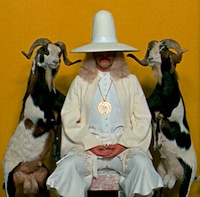
Goatstorm - Poster der Woche
- BeitrÀge: 7778
- Registriert: 9. November 2005, 13:24
- Wohnort: An den Feuern der Leyermark
Re: Das erste Metalalbum war ...
Dr. Best hat geschrieben:GravewarrioR hat geschrieben:zeig mir mal was von Quo das wirklich HEAQVY einschlĂ€ge /Proto-tendenzen erkennen lĂ€sst. Bei Molly Hatchet findste teilweise sowas, aber bei Quo is mir absolut nix bekannt. Wir reden hier ja von so Kapellen qie Uriah Heep oder Deep Purple. Die konnten auch ne bedrohliche athmosphĂ€re schaffen, Quo kenne ich nur als fröhlichen "Stadionrock". Ich lass mich gern eines anderen belehren, aber fĂŒr mich sind sie die Blaupause eines langweiligen Bikerfest-Headliners.
Also als "langweiligen Biker-Rock" wĂŒrde ich alles bis etwa 1978 ja nicht gerade bewerten. In meinen Ohren durchaus auf einer HĂ€rtestufe mit so mancher NWOBHM-Band, gerade wenn ich an Bands wie Quartz oder Tygers denke, ist das nicht weit weg:
Von der Geschwindigkeit her waren Status Quo natĂŒrlich oft alles andere als lahm, dennoch wĂŒrde ich die Riffs nicht als "metallisch" bezeichnen (vielleicht sogar eher als Punk VorlĂ€ufer) und an wenige frĂŒhe Tygers Of Pan Tang Songs kommen hĂ€rtemĂ€Ăig auch maximal die hĂ€rtesten von Status Quo heran (ab dem vierten Album haben die Tygers ja auch selbst nichts mehr mit Metal zu tun). Status Quo klangen auĂerdem halt einfach in den 70ern noch total nach den 60ern, das war bei Purple, Sabbath, Heep etc. doch anders, deren Musik war von Riffing und Songaufbau her irgendwie neuartiger.
Zuletzt geÀndert von Acrylator am 3. Mai 2013, 14:50, insgesamt 1-mal geÀndert.
meine Musik-Sammlung: http://www.musik-sammler.de/sammlung/shyclad
Meine Homepage: http://www.markusvesper.de/
Meine Homepage: http://www.markusvesper.de/
-

Acrylator - Sacred Metal-Legende
- BeitrÀge: 13247
- Registriert: 16. Januar 2008, 20:14
Re: Das erste Metalalbum war ...
Goatstorm hat geschrieben:
Ich bin mal einen Bestand von alten Musikmagazinen zwischen 1969 und 1975 durchgegangen. Das erste Review, in dem ich die Bezeichnung "Heavy Metal" in Bezug auf eine Band entdeckt habe, stammt aus dem Jahr 1970. Es geht um HUMBLE PIE's zweites Album. Das Review findet sich im Rolling Stone vom 12. November 1970 und wurde verfasst von Mike Saunders.
Black Sabbath wurden zur gleichen Zeit in der Regel noch als "Heavy Music" oder "Heavy Rock" bezeichnet.
Zu den Bands, die vor 1975 in den Magazinen als "Heavy Metal" bezeichnet wurden, zÀhlten unter anderem:
HUMBLE PIE, BLACK SABBATH, LED ZEPPELIN, GRAND FUNK RAILROAD, BLUE ĂYSTER CULT und DEEP PURPLE.
Im Phonograph Record Magazine vom April 1973 hab ich einen superinteressanten Artikel namens "A Brief Survey Of The State Of Metal Music Today" gefunden, ebenfalls von Mike Saunders verfasst. Das zeigt, dass "Heavy Metal" als Genrebezeichnung spÀtestens 1973 in den USA etabliert war, sonst hÀtte so ein Artikel keinen Sinn gemacht.
Die Bands, die in dem Artikel als "Heavy Metal" bezeichnet werden, sind: LED ZEPPELIN, BLACK SABBATH, URIAH HEEP, BLUE ĂYSTER CULT, GRAND FUNK RAILROAD, HAWKWIND (!!!), ALICE COOPER, DUST, MC5, THE STOOGES, TEN YEARS AFTER, UFO, VELVET UNDERGROUND (!!!) und als VorlĂ€ufer THE WHO und THE YARDBIRDS.
Saunders schreibt im gleichen Artikel auch noch drĂŒber, was fĂŒr ihn das Neue und Innovative an Heavy Metal darstellt:It's easy to note the changes in rock structure that heavy metal groups have employed: increased song length, for one. Five minutes has been about the average metal song duration, often even without any extended solos. Some stompers, like Dust's âFrom A Dry Camelâ and Led Zep's âWhen The Levee Breaksâ, run upwards of seven minutes, and none the worse for it.
Another metal innovation, perhaps the most obvious, would be the overwhelming emphasis on instrumental work rather than vocals. Save Uriah Heep, there have hardly been any groups in heavy metal with elaborate group vocals. You just stick a guy up before the mike, preferably the member of the band that can bop around the best, and let him go. As a result there have been some strange vocal styles, from Mark Farner's quavering shriek to Ozzy Osbourne's atonal yelp. The general attitude seems to be, what the hell...Robert Plant is about as technically adept as you get among metal vocalists, and the mere mention of Bobby's name has been known to cause people to break out laughing. Ian Gillan of Deep Purple does have quite a technically impressive voice, but he blows it by acting like an absolute narcissistic idiot on stage.
That the remaining field of heavy metal exploration has been technology â well, that goes without saying. Some of heavy metal rock has simply resembled nothing previously known to man nor beast â mainly the more extreme moments of Led Zep, Black Sabbath, Grand Funk, and Blue Oyster Cult â with the main mutation from traditional hard rock being in the rhythm section. A standout metal rhythm section really does resemble a steam press, belching along like a manic bulldozer flattening everything in its way. Sort of like a bass-drums equivalent of all that guitar noise on KICK OUT THE JAMS. I had been disappointed in how few metal groups have gotten into the esthetic of a really technocratic rhythm section on record, until I heard Blue Oyster Cult's recent promo LP, recorded live. The only description of Albert Bouchard's electrified, heavily miked drum kit would be that of a runaway locomotive at 250 MPH, and the
Cult themselves play like Zeus unleashed. Closest thing to an ultimate heavy metal sound I've yet heard.
One other footnote: heavy metal has coincided with a real trend back to rhythm guitar. Power chording is the term coined for the ideal metal rhythm guitar style (Tony Iommi of Black Sabbath was the runaway champion of this art for a while) and when you think about it, the technique dates back to âAll Day And All Of The Nightâ and all those other early Kinks singles. On which all rhythm guitar parts (the leads are still in dispute) were played by...Jimmy Page. The structure of most metal songwriting focuses around riffs and heavy chording, so the emphasis on rhythm guitar makes sense.
Quelle: Saunders, Mike: A Brief Survey Of The State Of Metal Music Today. In: Phonograph Record Magazine, 4/1973.
Das ist echt interessant, hÀtte gar nicht gedacht, dass der Genrebegriff schon vor 40 Jahren so etabliert war.
meine Musik-Sammlung: http://www.musik-sammler.de/sammlung/shyclad
Meine Homepage: http://www.markusvesper.de/
Meine Homepage: http://www.markusvesper.de/
-

Acrylator - Sacred Metal-Legende
- BeitrÀge: 13247
- Registriert: 16. Januar 2008, 20:14
Re: Das erste Metalalbum war ...
Hach, Status Quo, in der Rossi/Parfitt/Lancaster/Coghlan-Besetzung ein unschlagbares Riffrock-Monster.  *sÀuselseufz*
*sÀuselseufz*
-
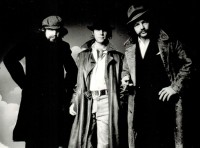
Siebi - Spaceman
- BeitrÀge: 18474
- Registriert: 22. Juli 2007, 13:08
Re: Das erste Metalalbum war ...
Siebi hat geschrieben:Hach, Status Quo, in der Rossi/Parfitt/Lancaster/Coghlan-Besetzung ein unschlagbares Riffrock-Monster.*sÀuselseufz*
Manchmal, da mag ich meinen Siebi.
AuĂerdem dank Goatstorms Interview-Attacke gelernt: Alice Cooper macht lĂ€nger Musik, als ich das in Erinnerung hatte, Humble Pie hatte ich vollkommen verdrĂ€ngt und Dust scheinen nicht so unbekannt zu sein wie ich immer dachte. Und: Velvet Underground sind Metal? Da macht die LuLu schon mehr Sinn
- The sound was so big I swear it created a new fjord behind us. -
-

Dr. Best - JOHN ARCH
- BeitrÀge: 4514
- Registriert: 28. April 2009, 11:41
- Wohnort: Brig
Re: Das erste Metalalbum war ...
Goatstorm hat geschrieben:
Zu den Bands, die vor 1975 in den Magazinen als "Heavy Metal" bezeichnet wurden, zÀhlten unter anderem:
HUMBLE PIE, BLACK SABBATH, LED ZEPPELIN, GRAND FUNK RAILROAD, BLUE ĂYSTER CULT und DEEP PURPLE.
Im Phonograph Record Magazine vom April 1973 hab ich einen superinteressanten Artikel namens "A Brief Survey Of The State Of Metal Music Today" gefunden, ebenfalls von Mike Saunders verfasst. Das zeigt, dass "Heavy Metal" als Genrebezeichnung spÀtestens 1973 in den USA etabliert war, sonst hÀtte so ein Artikel keinen Sinn gemacht.
Die Bands, die in dem Artikel als "Heavy Metal" bezeichnet werden, sind: LED ZEPPELIN, BLACK SABBATH, URIAH HEEP, BLUE ĂYSTER CULT, GRAND FUNK RAILROAD, HAWKWIND (!!!), ALICE COOPER, DUST, MC5, THE STOOGES, TEN YEARS AFTER, UFO, VELVET UNDERGROUND (!!!) und als VorlĂ€ufer THE WHO und THE YARDBIRDS.
Saunders schreibt im gleichen Artikel auch noch drĂŒber, was fĂŒr ihn das Neue und Innovative an Heavy Metal darstellt:
Logischerweise wurde Musik schon deutlich vor 79 als Heavy Metal bezeichnet.
Ansonsten wÀre das "New" in der NWoBHM ja nicht da.
Soundgarden z.B. waren in den 80ern auch Heavy Metal. Sie wurden i.d.R als Black Sabbath Epigonen gedisst/verehrt.
Und gewannen Polls als Beste/ Schlechtester Led Zeppelin Ripoff.
Dann kam der Cobain 91 mit "Nevermind" ebenfalls aus Seattle. Und schwupps waren Soundgarden Grunge.
Es gibt also durchaus einen Revisionismus was Genrezuordnungen angeht und er muss nicht immer wie im Falle Soundgarden kommerziell motiviert sein.
Ein Schreiberling der 75 halt nix anderes kennt, empfindet o.g. Bands natĂŒrlich als das HĂ€rteste, sprich Heavy Metal - gab ja nix anderes.
Aber sind Deep Purble, Humble Pie und Grand Funk Railroad auch noch Metal wenn man Overkill, Killing Machine oder Wheels of Steel gehört hat oder eher Hard Rock?
Man muss also unterscheiden:
Welches war das erste Metalalbum aus heutiger Sicht?
oder
Welches Album wurde als erstes als Metal bezeichnet?
Das Ergebnis wird nicht unbedingt deckungsgleich sein.
-
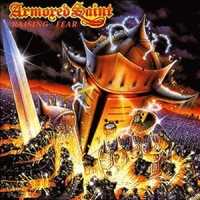
Vain Shangway - US Metal-Kenner
- BeitrÀge: 702
- Registriert: 15. Dezember 2010, 17:44
Re: Das erste Metalalbum war ...
Vain Shangway hat geschrieben:Goatstorm hat geschrieben:
Zu den Bands, die vor 1975 in den Magazinen als "Heavy Metal" bezeichnet wurden, zÀhlten unter anderem:
HUMBLE PIE, BLACK SABBATH, LED ZEPPELIN, GRAND FUNK RAILROAD, BLUE ĂYSTER CULT und DEEP PURPLE.
Im Phonograph Record Magazine vom April 1973 hab ich einen superinteressanten Artikel namens "A Brief Survey Of The State Of Metal Music Today" gefunden, ebenfalls von Mike Saunders verfasst. Das zeigt, das "Heavy Metal" als Genrebezeichnung spÀtestens 1973 in den USA etabliert war, sonst hÀtte so ein Artikel keinen Sinn gemacht.
Die Bands, die in dem Artikel als "Heavy Metal" bezeichnet werden, sind: LED ZEPPELIN, BLACK SABBATH, URIAH HEEP, BLUE ĂYSTER CULT, GRAND FUNK RAILROAD, HAWKWIND (!!!), ALICE COOPER, DUST, MC5, THE STOOGES, TEN YEARS AFTER, UFO, VELVET UNDERGROUND (!!!) und als VorlĂ€ufer THE WHO und THE YARDBIRDS.
Saunders schreibt im gleichen Artikel auch noch drĂŒber, was fĂŒr ihn das Neue und Innovative an Heavy Metal darstellt:
Logischerweise wurde Musik schon deutlich vor 79 als Heavy Metal bezeichnet.
Ansonsten wÀre das "New" in der NWoBHM ja nicht da.
Es hat hier doch niemanden gewundert, dass der Begriff Heavy Metal damals (oder auch vorher) schon aufgetaucht ist.
Bemerkenswert ist halt nur, dass es sich damals tatsÀchlich schon um einen etablierten Genrebegriff gehandelt hat.
meine Musik-Sammlung: http://www.musik-sammler.de/sammlung/shyclad
Meine Homepage: http://www.markusvesper.de/
Meine Homepage: http://www.markusvesper.de/
-

Acrylator - Sacred Metal-Legende
- BeitrÀge: 13247
- Registriert: 16. Januar 2008, 20:14
Re: Das erste Metalalbum war ...
Acrylator hat geschrieben:Vain Shangway hat geschrieben:Goatstorm hat geschrieben:
Zu den Bands, die vor 1975 in den Magazinen als "Heavy Metal" bezeichnet wurden, zÀhlten unter anderem:
HUMBLE PIE, BLACK SABBATH, LED ZEPPELIN, GRAND FUNK RAILROAD, BLUE ĂYSTER CULT und DEEP PURPLE.
Im Phonograph Record Magazine vom April 1973 hab ich einen superinteressanten Artikel namens "A Brief Survey Of The State Of Metal Music Today" gefunden, ebenfalls von Mike Saunders verfasst. Das zeigt, das "Heavy Metal" als Genrebezeichnung spÀtestens 1973 in den USA etabliert war, sonst hÀtte so ein Artikel keinen Sinn gemacht.
Die Bands, die in dem Artikel als "Heavy Metal" bezeichnet werden, sind: LED ZEPPELIN, BLACK SABBATH, URIAH HEEP, BLUE ĂYSTER CULT, GRAND FUNK RAILROAD, HAWKWIND (!!!), ALICE COOPER, DUST, MC5, THE STOOGES, TEN YEARS AFTER, UFO, VELVET UNDERGROUND (!!!) und als VorlĂ€ufer THE WHO und THE YARDBIRDS.
Saunders schreibt im gleichen Artikel auch noch drĂŒber, was fĂŒr ihn das Neue und Innovative an Heavy Metal darstellt:
Logischerweise wurde Musik schon deutlich vor 79 als Heavy Metal bezeichnet.
Ansonsten wÀre das "New" in der NWoBHM ja nicht da.
Es hat hier doch niemanden gewundert, dass der Begriff Heavy Metal damals (oder auch vorher) schon aufgetaucht ist.
Bemerkenswert ist halt nur, dass es sich damals tatsÀchlich schon um einen etablierten Genrebegriff gehandelt hat.
Mehr oder weniger etabliert.
Z.B. fÀllt mir da ein Interview mit Iommi ein, wie er damals Mitte der 70er von einem Journalisten mit dem Begriff "Heavy Metal" konfrontiert wurde.
"Was ist das?" - "Na, das was ihr spielt".
-

Vain Shangway - US Metal-Kenner
- BeitrÀge: 702
- Registriert: 15. Dezember 2010, 17:44
Re: Das erste Metalalbum war ...
Ich finde, man kann, nein, man muss noch ein bisschen tiefer Graben, um auf den wahren Protometal zu stoĂen. Etwa hier, bei diesem Landsknecht-Retrosong von 1919 hat man schon alle spĂ€teren Bausteine fĂŒr episch-deftigen Metal beieinander. Da wĂ€re der typisch teutonische, bis heute in der Szene umstrittenen Choreinsatz, der sich steigernde Refrain, fast schon thrashige Drums sowie textlich eine sofort erkennbare Mischung aus MANOWAR-Kraftmeierei (Frauen rauben, StĂ€dte niederbrennen..) und SABBATH-mĂ€Ăigem Fatalismus, bzw. gar VENOM/MERCYFUL FATE-mĂ€Ăigem Antiklerikalismus. Dazu in GRAVE DIGGER-Manier mit striktem Focus auf ein historisches Ereignis, in dem Fall den deutschen Bauernkrieg des 16. Jhd. Und, als ob es noch eines Beweises bedurft hĂ€tte, eine HEINO-Coverversion gab es auch schon, ha!






Muss rispettieren die andere Kollega!
-
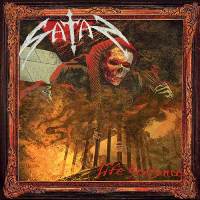
Sgt. Kuntz - Leather Lucifer
- BeitrÀge: 8386
- Registriert: 7. Dezember 2008, 12:46
- Wohnort: Bayern
Re: Das erste Metalalbum war ...
Sgt. Kuntz hat geschrieben:Ich finde, man kann, nein, man muss noch ein bisschen tiefer Graben, um auf den wahren Protometal zu stoĂen. Etwa hier, bei diesem Landsknecht-Retrosong von 1919 hat man schon alle spĂ€teren Bausteine fĂŒr episch-deftigen Metal beieinander. Da wĂ€re der typisch teutonische, bis heute in der Szene umstrittenen Choreinsatz, der sich steigernde Refrain, fast schon thrashige Drums sowie textlich eine sofort erkennbare Mischung aus MANOWAR-Kraftmeierei (Frauen rauben, StĂ€dte niederbrennen..) und SABBATH-mĂ€Ăigem Fatalismus, bzw. gar VENOM/MERCYFUL FATE-mĂ€Ăigem Antiklerikalismus. Dazu in GRAVE DIGGER-Manier mit striktem Focus auf ein historisches Ereignis, in dem Fall den deutschen Bauernkrieg des 16. Jhd. Und, als ob es noch eines Beweises bedurft hĂ€tte, eine HEINO-Coverversion gab es auch schon, ha!


Hey das klingt super! Genau meine Baustelle. Wo gibts das Vinyl?
-

Dörk - Villain-EP-Original-Besitzer
- BeitrÀge: 855
- Registriert: 21. April 2010, 17:22
- Wohnort: A Mansion In Darkness
Re: Das erste Metalalbum war ...
Dörk hat geschrieben:Sgt. Kuntz hat geschrieben:Ich finde, man kann, nein, man muss noch ein bisschen tiefer Graben, um auf den wahren Protometal zu stoĂen. Etwa hier, bei diesem Landsknecht-Retrosong von 1919 hat man schon alle spĂ€teren Bausteine fĂŒr episch-deftigen Metal beieinander. Da wĂ€re der typisch teutonische, bis heute in der Szene umstrittenen Choreinsatz, der sich steigernde Refrain, fast schon thrashige Drums sowie textlich eine sofort erkennbare Mischung aus MANOWAR-Kraftmeierei (Frauen rauben, StĂ€dte niederbrennen..) und SABBATH-mĂ€Ăigem Fatalismus, bzw. gar VENOM/MERCYFUL FATE-mĂ€Ăigem Antiklerikalismus. Dazu in GRAVE DIGGER-Manier mit striktem Focus auf ein historisches Ereignis, in dem Fall den deutschen Bauernkrieg des 16. Jhd. Und, als ob es noch eines Beweises bedurft hĂ€tte, eine HEINO-Coverversion gab es auch schon, ha!


Hey das klingt super! Genau meine Baustelle. Wo gibts das Vinyl?
Ja Dirk, der Song dĂŒrfte dir doch eigentlich bekannt vorkommen. Die Kollegen von Absurd haben den auch schonmal gecovert
-

Prowler88 - Prog-Rock-Fan
- BeitrÀge: 161
- Registriert: 1. Januar 2013, 19:13
Re: Das erste Metalalbum war ...
Dörk hat geschrieben:Hey das klingt super! Genau meine Baustelle. Wo gibts das Vinyl?
Gibt es auf dieser LP-Version:
http://www.amazon.de/Landsknechtstromme ... 31&sr=1-10
Bei ebay auch grad erhÀltlich.
Auf der Version ist auch das berĂŒhmte âWildgĂ€nse rauschen durch die Nachtâ drauf, das bei YouTube von irgendwelchen Deppen leider immer mit Wehrmachts-Bildern âveredeltâ wird, schade eigentlich um dieses textlich(aus einem sehr lesenswerten Buch von Walter Flex) und musikalisch tolle Liedgut.
Muss rispettieren die andere Kollega!
-

Sgt. Kuntz - Leather Lucifer
- BeitrÀge: 8386
- Registriert: 7. Dezember 2008, 12:46
- Wohnort: Bayern
ZurĂŒck zu Heavy Metal Universe
Wer ist online?
Mitglieder in diesem Forum: Google [Bot], mike und 13 GĂ€ste
